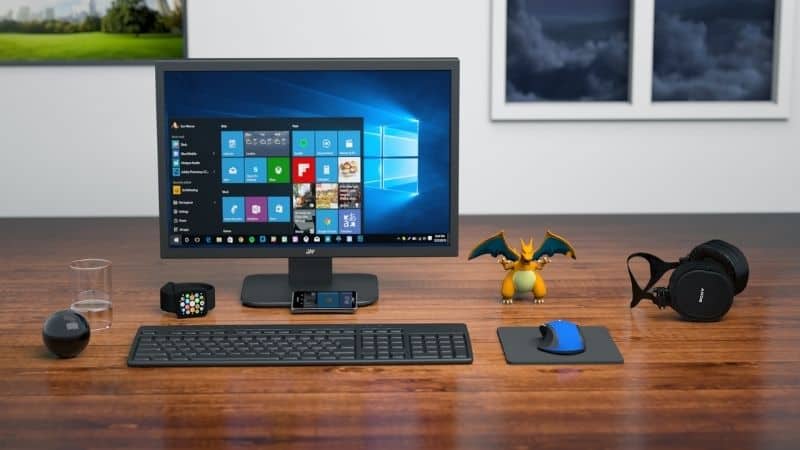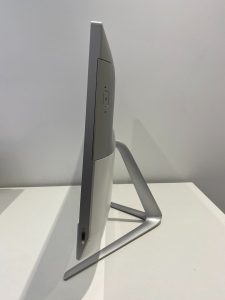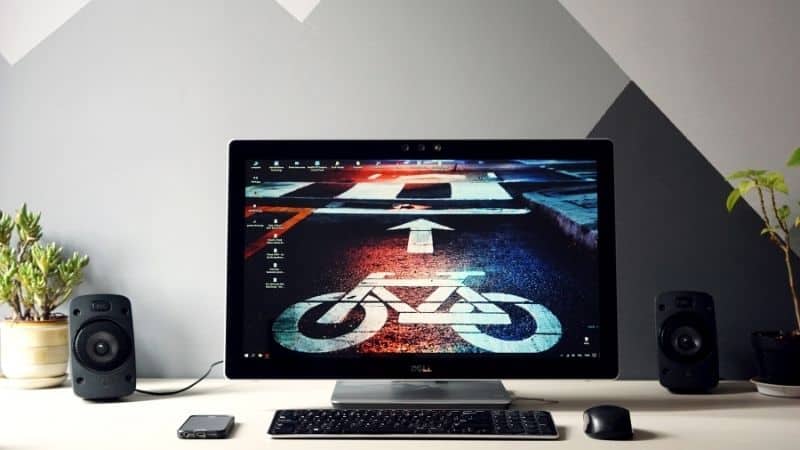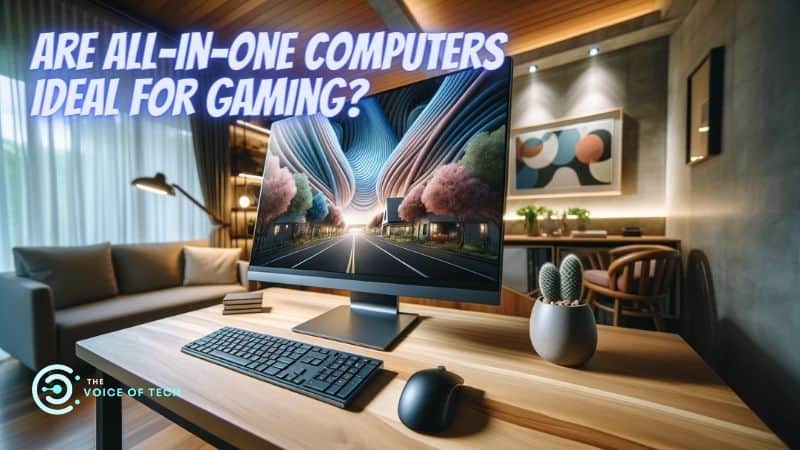
Expert Consulted: Adrian Gardiner. With 30+ years in the IT industry, I get frequent requests to repair, upgrade, and build a wide range of computers, including new gaming PCs. This experience has given me helpful knowledge that I can share to advise on whether All-in-One computers are the ideal choice for gaming.
I have a number of customers who use All-in-One computers, and they certainly do look nice, even more so because they usually come with a wireless mouse and keyboard, making them tidier, too.
An All-in-One computer is essentially a display screen with all the usual computer components built into the back just behind the screen.
But are all-in-one computers ideal for gaming?
All-in-One computers, while convenient and space-saving, are not typically ideal for serious gaming. Their compact design makes it impossible to upgrade essential components like graphics cards, and they don’t provide optimal cooling for intensive gaming tasks. Dedicated gaming PCs, with customizable and upgradable parts, remain the best choice.
Read on to find out more about why All-in-One computers struggle with gaming and what their true calling is for most users.
This post contains affiliate links. Click here to read our affiliate policy.
Are All-In-One Computers Ideal for Gaming? Weighing the Pros and Cons
All-in-One computers have been around for years now but haven’t really taken off in great numbers. In my own line of work, which includes looking after customers with computer-related problems, I don’t really see that many.
The cost has previously been prohibitive, but they’re more affordable now than they ever were.
The main attraction of an All-in-One computer is saving space from their slim design, plus the reduction in cables from usually only having a power cable into the back as many are supplied with a wireless mouse and keyboard.
Why All-In-One Computers Struggle with Gaming
These computers are not designed with gaming in mind from the outset but are produced to provide a nice, slim, space-saving, and less cluttered version of a desktop computer for everyday computing needs – basically, a screen with a built-in computer.
The hardware built into an All-in-One computer is usually similar to that found in a laptop and is carefully optimized to ensure it is as energy-efficient as possible and also doesn’t generate too much heat.
This means, barring a few exceptions, the included hardware (i.e., CPU and Graphics) is not going to be as powerful as the equivalent parts fitted to a gaming desktop.
A gaming desktop won’t usually have issues with space, so is better able to get rid of generated heat through much-improved ventilation.
If you wanted your lovely, super slim, All-in-One computer to compete with a gaming desktop, imagine trying to cram in a full-size RTX 4070 graphics card, for example!
It’s simply not possible to upgrade anything on these computers except maybe adding more RAM or fitting a larger storage drive.
The graphics in an All-in-One computer are going to be of the integrated type to minimize the space taken up and maximize efficiency.
Casual gaming is possible, of course, and you might just be able to install and run some of the more powerful games available, but only at minimum settings, with low frame rates and questionable onscreen quality.
If you want to play the latest power-hungry games, you’ll need a proper gaming desktop.
Advantages of All-In-One PCs

All-in-One computers have some useful advantages over their desktop alternatives, which means they will only get better and maybe have improved gaming capabilities in the future.
Space Saving Design

All-in-one computers tend to be favored by those looking to save space and perhaps have a nicer-looking PC that isn’t going to be an eyesore in someone’s home.
A standard desktop PC can look bulky and untidy with all the cables connecting up a monitor to the PC and a power cable for each – most clients I visit have a problem trying to keep everything looking tidy plus keeping their set up free of dust.
Built-in Touchscreen
Another common feature of All-in-One computers is a touch screen. For those who struggle with a mouse and keyboard, a touch screen can be a welcome and helpful addition. It can also be useful with certain games and just general usage but will never replace a full-size keyboard, of course.
It’s also worth mentioning, though, that these touchscreens aren’t yet quite as responsive or precise as the touchscreens found in tablets or consoles.
Easier to Install
An All-in-One PC is much easier to install, making it attractive for those users less familiar with setting up computer systems. With just a single power cable out of the back of the unit (and usually a wireless mouse/keyboard), all you have to do is place it on a suitable surface, plug it into the mains, and turn it on.
Easier to Keep Clean
With their slim design and placement on a desk or table, an All-in-One computer is easier to get to and, therefore, much easier and quicker to keep clean.
Desktop computers are usually positioned on or close to the floor and often in tight-fitting cupboard spaces (not the best for cooling) – this means that they gather more dust and are also harder to access and clean.
You also then still have to clean the monitor, which is a separate component in this desktop computer setup.
Disadvantages of All-In-One PCs

There are a few disadvantages to having an All-in-One computer that are worth taking into account when looking for your next computer.
Gaming Performance
All-in-One computers usually don’t have the necessary hardware to be able to enjoy anything other than casual gaming, especially the latest AAA game titles at decent in-game settings.
There are a few exceptions, like the HP Envy 34″ All-in-One Gaming Desktop, which is kitted out with some impressive hardware, including an RTX 3060 GPU.
Upgradability
Upgrading an All-in-One computer is usually limited to just upgrading the RAM or fitting a larger / better storage drive. Upgrading the graphics or power supply, for example, would be impossible.
Upgrading a desktop PC is usually much easier, with the option of being able to choose from a wide range of off-the-shelf and relatively easy-to-fit computer parts to upgrade.
Cooling
Of those All-in-One computers that I’ve had to work on, cooling has often been an issue. They have a similar problem to laptops, where all the components are sandwiched together into a tight space behind the display, making cooling more of a challenge.
When computer parts start to get hot, especially over an extended period of time, unfortunately, you can expect problems.
Expensive to Repair
If anything goes wrong with an All-in-One computer, the repair costs can be high due to the bespoke nature of the components used and the labor involved in accessing everything in such a tight-fitting design – in my experience, they can be troublesome to take apart, and often don’t want to go back together easily.
If the screen or graphics fail, then you’re usually looking at a complete replacement computer due to high replacement component costs.
In contrast, a desktop PC is much easier to work on and repair, reducing the costs involved considerably.
Final Thoughts
So, are All-in-One computers ideal for gaming? No, in general, not really. The All-in-One computer concept was never designed with gaming in mind, so they usually aren’t the right computer choice if gaming is mainly what you want to do.
There are a few exceptions that you can purchase with more gaming power, but generally, most are only really capable of casual gaming.
All-in-One computers look great, are easy to install, and are easy to get going once you’ve got them unpacked. They also often come with a handy touchscreen and are easy to keep clean.
However, upgrades are limited to just RAM and storage, so choose your specifications carefully before buying so to ensure that your All-in-one computer lasts as long as possible.
If you’re short on space and want a computer that looks nice, is easy to manage, and you are not too worried about gaming power, an All-in-One computer may be the best choice for your computing needs.

